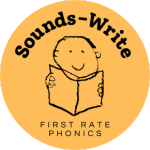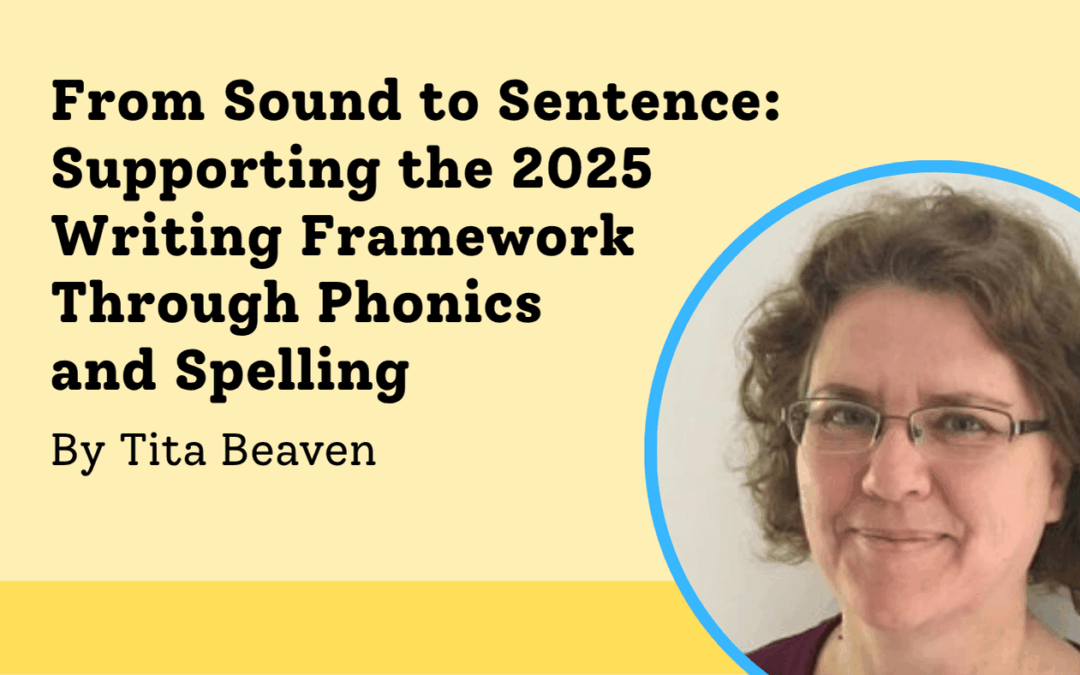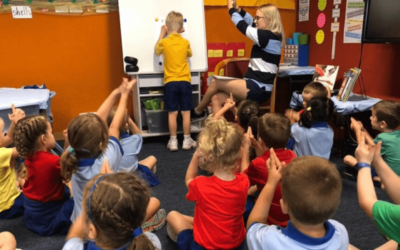The newly-published Writing Framework (2025) and the Reading Framework (2023) together offer schools a clear, research-informed direction: secure the foundations of reading and writing early, and build on them progressively throughout primary education. They emphasise that decoding, spelling, handwriting, grammar, and composition are not isolated skills but interconnected components of literacy that need to be taught explicitly and cumulatively.
This has important implications for how schools approach phonics teaching—not just in the early years, but well into Key Stage 2. For schools using a phonics programme that includes both reading and spelling from the start and extends into later primary years, the frameworks offer helpful validation and direction. At Sounds-Write, we have long argued that the teaching of phonics should continue into KS2, so it’s good to see our approach validated by the Writing Framework.
Jump to section
From decoding to encoding: why spelling matters early
Phonics in Key Stage 2: continuing, not concluding
From phonemes to morphemes: deepening spelling knowledge
Dictation: a low-cost, high-impact strategy
Reducing Cognitive Load to support writing
Creating coherence across the Curriculum
Reflection points
From decoding to encoding: why spelling matters early
Both frameworks make a strong case for teaching spelling through phonics, particularly in the early stages. The Reading Framework reinforces Gough and Tunmer’s (1986) Simple View of Reading, which posits that word recognition and language comprehension are essential components of reading comprehension. The Writing Framework uses the parallel model of the Simple View of Writing (Berninger et al. 2002) whereby transcription (spelling and handwriting) and composition are both essential components of writing which must be mastered.
One of the implications highlighted by the Writing Framework is that although “Fluent writers show automaticity in writing words, allowing them to convey their intended meaning” (p. 4), students who can read words fluently are not necessarily ready to write them fluently.
At Sounds-Write, we acknowledge that reading and spelling differ in their perceived difficulty, in that reading draws on recognition memory, whereas spelling draws on recall or retrieval memory. Retrieval is much harder than recognition because, when reading we have a cue in front of us – the words on the page; when we are spelling there is no cue, we have to retrieve the spellings from our memory. That’s why we suggest that, when doing dictation, there should be a lag between the code that is currently being taught and the code that is having to be retrieved in the dictation.
The Writing Framework explains that teaching encoding—how to segment a word into phonemes and represent those with graphemes—is critical. When children learn to spell alongside reading, they develop a more robust understanding of how the alphabetic code works, which can reduce cognitive load later when they begin composing longer texts and helps get spelling knowledge into long-term memory. That is why in Sounds-Write students’ writing is a key component of our teaching from the start – when children in Reception learn how to build the word ‘mat’, they also write it, and when students in Y6 read the polysyllabic word ‘hemisphere’, they also write it. This is not a new approach, as Maria Montessori and Noah Webster were both strong advocates many years ago.
Phonics in Key Stage 2: continuing, not concluding
A significant message from both frameworks is that phonics should not stop once students pass the Year 1 Phonics Screening Check. For many students, particularly those with weaker working memory or less exposure to language at home, continued phonics instruction into Key Stage 2 is essential.
“Pupils should continue to use phonics throughout primary school to help them spell.” (Writing Framework, 2025)
The Writing Framework shares the story of Sophie, a student who reached the phonics threshold in Year 1 but didn’t receive further support with spelling. By Key Stage 2, she was struggling to express her ideas in writing—not because of a lack of imagination or vocabulary, but because spelling and handwriting still took up too much of her mental energy.
Schools that continue phonics instruction beyond the early years—especially those using a programme that includes a Key Stage 2 component such as the Sounds-Write Y3-6 course—are better positioned to close these kinds of gaps and support students to become fluent, confident writers.
From phonemes to morphemes: deepening spelling knowledge
The Writing Framework acknowledges that spelling in English becomes increasingly complex as students progress. It isn’t enough to rely solely on phonics; students also need to understand morphology (prefixes, suffixes, and root words), orthographic patterns, and, to some extent, etymology.
Phonics programmes, like Sounds-Write, that integrate these elements—moving from simple to complex code and from simple to complex word structure – from CVC words to polysyllabic words and morphemes—provide an essential phonics curriculum that extends into KS2. When this progression is clearly mapped and taught explicitly, students are better equipped to tackle both reading and writing challenges as texts become more sophisticated.
Dictation: a low-cost, high-impact strategy
Both frameworks recommend dictation as a highly effective practice that supports spelling, sentence structure, and writing fluency. Dictation allows students to rehearse what they’ve been taught in phonics without the added pressure of generating original content.
“Dictation is helpful for all children so that they can practise the transcription they are taught.” (Writing Framework, p. 26)
Regular dictation—whether it’s a single word, a phrase, a sentence, or a short passage—gives students the opportunity to internalise the spelling patterns and sentence structures they are learning. It also provides valuable opportunities for formative assessment, especially for identifying common errors or misconceptions. As we like to say in Sounds-Write, dictation is a ‘contextualised spelling quiz’, which we strongly recommend should take place two or three times a week.
Reducing Cognitive Load to support writing
One of the clearest findings across both frameworks is that transcription must become automatic before students can focus effectively on composition. If students are still thinking hard about how to form a letter or how to spell a common word, they have little mental energy left to organise ideas, vary sentence structures, or think about their audience.
“A pupil who is concentrating on their handwriting and spelling (transcription) will find it very challenging to put what they want to say on paper.” (Writing Framework, p. 19)
The more secure and fluent students are in spelling and handwriting, the more they are able to focus on shaping their ideas and developing as writers. This reinforces the importance of embedding phonics-based spelling instruction into everyday practice, not just during reading time but as a core part of writing instruction. To those recommendations from the Writing Framework we would add that, whether it’s in the phonics session or when students are reading or writing across the curriculum, using consistent approaches to giving immediate feedback and error correction is key. That’s why we provide Teaching Through Errors strategies and scripts as part of the Sounds-Write programme.
Creating coherence across the Curriculum
Perhaps the most useful takeaway for school leaders is that the Reading and Writing Frameworks don’t advocate separate approaches to literacy, but a coherent one. Phonics isn’t something that belongs only in Reception and Year 1, or only to reading. Instead, it’s a tool that supports all students to become more confident, capable, and independent readers and writers—across subjects and across key stages.
For schools using a programme that is systematic, cumulative, and structured to support both reading and spelling from Reception to Year 6, these frameworks affirm that such an approach is not only compatible with national expectations but helps meet them more effectively.
If your school is reviewing how phonics, spelling, and writing instruction fit together across the primary phase, these frameworks offer a helpful structure for reflection. Look at how transcription is being taught, how long phonics continues, and whether students have regular opportunities to practise and apply their knowledge. The stronger these foundations are, the more likely students are to flourish as readers and writers.
Reflection points
Here are some reflection points for your team at school to discuss:
- Does your phonics programme provide systematic and explicit teaching of both decoding and encoding (reading and spelling) from the start of Reception and into KS2?
The Writing Framework is clear that phonics instruction should be direct, cumulative, and systematic. Teaching spelling (encoding) alongside reading strengthens understanding of the alphabetic code and supports early writing development.
- Does your school avoid introducing joined handwriting too early — ensuring that pupils first develop accurate, fluent single-letter formation?
The Writing Framework is clear that joined handwriting should not be introduced until children can form all letters correctly and automatically. Starting too early can undermine fluency, introduce confusion, and increase cognitive load. A consistent, whole-school approach that prioritises secure, automatic letter formation lays the groundwork for confident, legible joined handwriting later.
- Does your phonics programme teach the 175 or so most common spellings to represent the 44 or so sounds in English, cumulatively and systematically?
The framework emphasises the importance of teaching the full alphabetic code, not just the early part. Students need to be taught the common phoneme-grapheme correspondences) in a way that builds knowledge over time and avoids confusion from ad hoc or ‘rule-of-the-week’ approaches.
- Does the programme include regular opportunities for students to apply their phonics knowledge in writing — for example through dictation, sentence work, and oral rehearsal?
Applying phonics through writing consolidates learning and supports the development of transcription fluency. Dictation is specifically recommended as a strategy to reduce cognitive load and strengthen encoding.
- Does the programme teach students to move beyond simple phoneme-grapheme correspondences and introduce morphology, polysyllabic words, and more complex spelling patterns in a structured and progressive way?
By the end of Key Stage 1 and into Key Stage 2, students need explicit teaching in morphemes (e.g. prefixes, suffixes) and more complex orthographic knowledge. The programme should support this transition.
- Is there a clear process for identifying students who are not keeping up — and a structured, consistent intervention pathway using the same phonics approach?
The Framework emphasises the need for early identification and timely support. Catch-up and keep-up strategies should be part of the core phonics provision, not separate or ad hoc.
You may also like
The Cumulative Nature of Sounds-Write: Supporting Progress Towards the Phonics Screen Check
When considering the Phonics Screening Check and the code knowledge that needs to be learned, there can sometimes be an urgency to ‘get through’ the scope and sequence. The beauty of Sounds-Write is that the scope and sequence follow a cumulative nature, meaning you...
PSC: Mid-Year Strategies to Ensure Everyone is On Track
The PSC (Phonics Screening Check) may seem some time away yet but, at Sounds-Write, we recommend that you review what your class has been doing so far to make plans for the months ahead. Let us guide you! In this blog, we’ll explain how you can use the tools we’ve...
Mastering Phonemic Awareness: Your Key to PSC Success
The PSC (Phonics Screening Check) is as much a test of phonemic awareness skills and conceptual understanding as it is of code knowledge. This blog will explore why it is so important that these skills are practised to automaticity and what you can do to ensure that...




